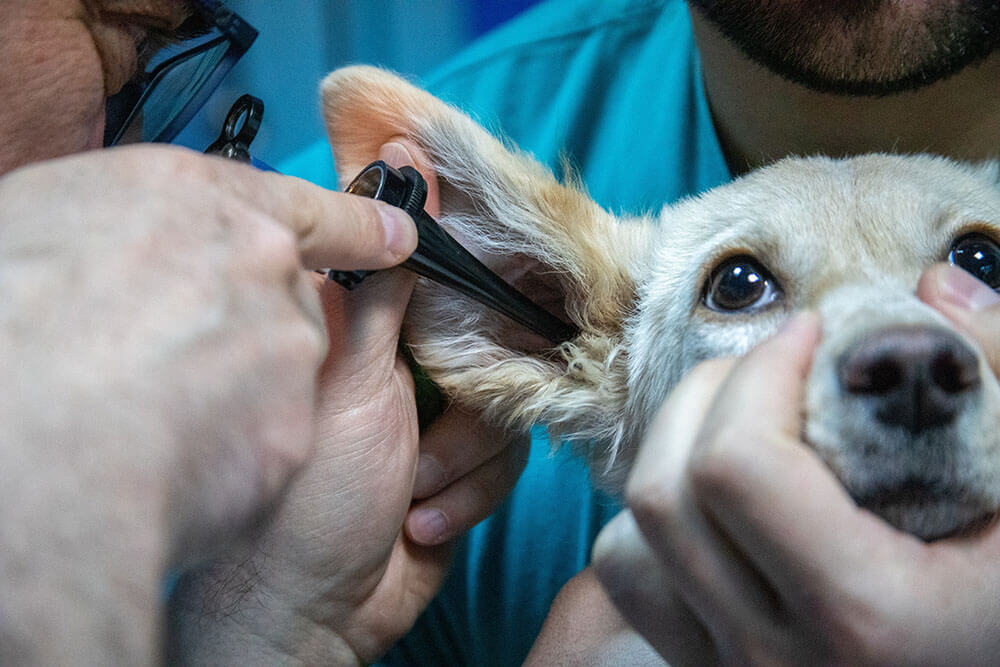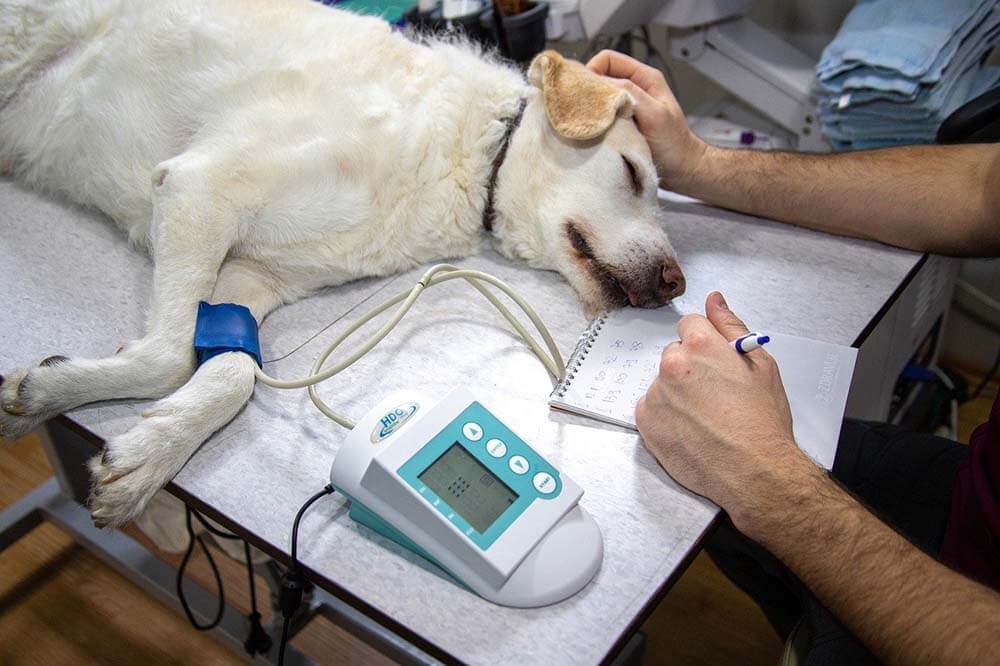Dogs tremble for various mundane reasons, from irrepressible joy to a reaction to cold weather.
But are there abnormal reasons for a dog’s shivering? Can it be a sign your dog needs veterinary treatment?
Join us as we explore the many causes of shaking in dogs!

Top Reasons for Dog Shivering
The reasons why a dog is shivering and trembling can be split into 3 categories: behavioral, environmental, and medical.
1. Behavioral
Trembling is a natural aspect of any dog’s behavior. However, this doesn’t always mean your dog’s trembling isn’t a sign of a problem.
Excitement
Do you notice your dog shaking every time you come home from work? Your fur baby is likely extremely happy to see you. To express their joy, they’ll yap, wag their tail, run in circles, and shake all over. This is natural.
In fact, any positive experience can make your dog shake. If they’ve scented the meal you’re preparing for them, they’ll tremble in anticipation. If they’re playing with you or other canine pals, the thrill and physical exertion can make them shiver.
Puppies and adolescent dogs are particularly prone to overexcitement, so don’t be alarmed if they start quaking whenever a guest visits your home.
Anxiety, stress, or fear
When a dog feels unsafe, adrenaline floods their body so that they can react more quickly, helping them either fight or flee from potential danger. All that adrenaline causes your dog’s body to tremble.
While this is natural, it should also tell you your dog isn’t in a great mood. For example, if your dog shivers during a thunderstorm, it means they’re frightened by the loud noises. You should try to calm them down by speaking to them in soothing tones and giving them a place they can crawl into to feel safer, such as a crate.
If your dog trembles every time a stranger visits the house, they may have chronic anxiety. A vet can prescribe anti-anxiety medication, while an animal behaviorist can determine the root of your dog’s anxiety and develop strategies to help them overcome it.
Other signs your dog is experiencing emotional distress include excessive panting, pacing, whimpering, a tucked tail, flattened ears, and hiding.
Check out this article for tips on how to help an anxious, stressed, or fearful dog.
Estrous cycle
When unspayed female dogs enter the reproductive cycle’s estrus stage (commonly known as being “in heat”), they’re ready to mate. It’s normal for such dogs to display several ordinary behaviors that may seem worrying to the untrained eye.
A dog in heat may tremble, urinate more frequently, become restless, and seem nervous. Extra exercise, including long walks, can help her release her excess energy. You can also distract her by giving her toys and treats.

2. Environmental
If your dog is shaking, their body may be reacting to their surroundings.
Feeling cold
Shivering is a natural reaction to cold. Cold causes the muscles to tighten and relax repeatedly, which generates the heat your dog needs to stay warm.
Some canines are less tolerant of low temperatures than others. For example, small dog breeds with short hair, such as Chihuahuas and Dachshunds, don’t do well in regions with perpetually cold climates. You can keep such pets warm by clothing them in sweaters and boots and giving them a warm blanket. Make sure your house has warm places they can curl up in, as well.
Shaking themselves dry
After a dog gets wet, they vigorously shake their body to remove water from their coat.
The canine coat traps heat and keeps the dog warm. Unfortunately, it also retains water. Therefore, perfectly healthy dogs shake themselves dry. In fact, this behavior can remove around 70% of water in as few as four seconds, making it far more effective than body heat at drying the dog’s body.

3. Medical
Once you’ve established that behavioral or environmental reasons aren’t behind your dog’s shaking, you should consider the possible medical causes of shivering.
Some of these issues are easily managed. Others, however, require more intensive care.
Nausea
Does your dog feel nauseous? If they do, they may end up trembling, which is one of the symptoms of nausea.
Other nausea symptoms include:
- Salivation
- Frequent swallowing
- Lip-smacking
- Vomiting
Nausea has many causes, including motion sickness, overeating, eating the wrong thing (such as dairy or oily food), and a side effect of taking medication.
Nausea can be a symptom of serious conditions such as kidney disease, liver disease, and toxicity.
Upset stomach
If a dog is shaking, try to determine what they ate. They may have an upset stomach, which can lead to diarrhea and/or vomiting.
Before treating your pet yourself, contact a veterinarian so they can give you advice on how to care for your dog properly. Your dog will likely be made to fast for 12 to 24 hours, then observe a bland, low-fat diet for a few days.
The shivering and trembling usually cease after your dog empties their bowels or stomach. But if such symptoms persist, your dog will benefit from being taken to the vet.
Canine distemper
Canine distemper is an exceedingly contagious viral disease usually occurring in unvaccinated young dogs. Tremors are among its most common symptoms.
As distemper affects the respiratory, gastrointestinal, and central nervous systems, its other symptoms include:
- Coughing and/or sneezing
- Runny nose
- Eye discharge
- Lethargy
- Fever
- Reduced appetite
- Vomiting or diarrhea
Treating this disease requires supportive care that often involves the use of antibiotics, fluids, airway dilators, and physical therapy.
If your dog displays distemper symptoms, take them to the vet immediately before their condition worsens or they infect other dogs.
Ear problems
Any issue affecting the ears can result in head shaking in dogs.
Ear mites, ear infections, ear injuries, and a foreign object stuck in the ears are among the most common reasons why a dog shakes their head repeatedly and vigorously.
Other signs of ear issues include:
- Red, swollen ear canal
- Ear itchiness that encourages scratching
- Scabs or crusting in the ears
- Pain
- Odor
- Dark discharge
If your dog’s ear concerns aren’t going away, take them to the vet’s office. Treatment depends on the specific malady but usually involves cleaning the ears and applying topical medication.

Hypothermia
While it’s normal for healthy dogs to shiver when they’re cold, prolonged exposure to extremely low temperatures can cause hypothermia.
Shivering and trembling are often the first signs of mild hypothermia. In some cases, a dog’s shivering stops as the condition grows worse.
Symptoms of moderate to extreme hypothermia include:
- Whining
- Curling up
- Cold feet, ears, and tail
- Pale, gray, or bluish gums
- Dilated pupils
- Increased heart rate, then reduced heart rate
- Depression
- Sluggishness
- Fainting
Any dog exhibiting such symptoms should be taken to the vet immediately for life-saving treatment.
Generalized tremor syndrome (GTS) a.k.a. white shaker dog syndrome
Generalized tremor syndrome (GTS) goes by many names, including white shaker syndrome and idiopathic cerebellitis. While it was first observed in small dogs with white hair (thus the name “white shaker”), it can also occur in larger dogs of any color or breed.
GTS impacts the central nervous system – particularly the brain region responsible for muscle coordination. Therefore, it causes involuntary, repetitive, and rhythmic trembling, which may be localized or involve the entire body. As one of its other symptoms includes low body temperature, it may be confused for hypothermia.
Treatment requires the use of prednisone or other corticosteroids.
The cause of GTS is unknown, but it’s thought to be autoimmune-related. White dogs such as West Highland White Terriers, Samoyeds, and Maltese Dogs are particularly prone to GTS.
Seizure disorders
If a dog is shaking episodically, they may have a neurological disorder such as epilepsy.
In addition to causing acute, involuntary muscle tremors, seizure disorders can give rise to the following symptoms:
- Drooling
- Tongue chewing
- Foaming at the mouth
- Restlessness
- Head shaking
- Jerky motions
- Stiffness
- Loss of consciousness
- Collapse
If a dog collapses to their side during a seizure, their legs may flail as if they’re swimming or running. Seizures themselves aren’t painful. However, any fall can harm your dog especially if they hit their head on something hard and sharp. For this reason, make sure your dog has something soft and comfortable to lie on (such as a pillow and blanket) during an episode. Remain calm, avoid touching or holding your dog down, and let the tremors subside naturally. Once your pet is back to normal, offer them some drinking water.
Chronic conditions like epilepsy require long-term medication by a vet. Potassium bromide, phenobarbital, and keppra are used to control seizures.
Heat exhaustion
Is your dog shivering after spending too much time in the sun or a sealed, stuffy car? They may be suffering from heat exhaustion.
Prolonged exposure to heat causes the dog’s body temperature to rise to dangerous levels. It’s much worse if your dog is stuck in an enclosed, high-humidity space, as such conditions prevent your dog from cooling down no matter how much they pant.
In addition to involuntary muscle twitching, the other signs of heat exhaustion include:
- Excessive panting
- Breathing difficulty
- Excessive drooling
- Fever
- Rapid pulse
- Lack of urine
- Bluish, purple, gray, or bright red gums
- Weakness or lethargy
- Dizziness
- Vomiting or diarrhea
If heat exhaustion isn’t treated, your dog can get heatstroke, a medical emergency that may result in seizures, collapse, a coma, brain damage, and death. Therefore, take your dog to the veterinarian immediately if you observe the above symptoms. Their life depends on it!
To prevent heat exhaustion, ensure your dog has easy, regular access to cool drinking water, and never leave them inside a car especially when it’s warm outside. During hot weather, only walk them after sunset and before sunrise.

Bloat
Also known as gastric dilatation and volvulus (GDV), bloat is a painful and potentially fatal condition affecting thousands of dogs all over the world per year.
In serious cases, bloat twists a dog’s stomach at both ends, preventing its contents from escaping and major organs from receiving blood.
In addition to tremors, signs of bloat include:
- Pacing and restlessness
- Distended or swollen abdomen
- Painful abdomen
- Retching/failure to vomit
- Excess drooling
- Excess panting
- Rapid breathing
- Collapse
Left untreated, bloat causes toxins to accumulate in your dog’s tissues, which can be deadly. If your dog’s shakes are accompanied by the above symptoms, they need emergency medical attention, so bring them to the vet as soon as possible.
It’s unknown what causes bloat, though certain factors may contribute to its development. These factors include overeating, eating quickly, drinking large quantities of water rapidly, elevated food bowls, exercising after eating, and old age.
Addison’s disease
Also known as hypoadrenocorticism, Addison’s disease occurs when a dog’s adrenal glands become impaired so they produce abnormally low levels of the steroid cortisol. This can result in other internal organs not working properly.
Addison’s disease can affect dogs to cause intermittent shivering as well as the following symptoms:
- Vomiting
- Diarrhea
- Excessive thirst
- Increased urination
- Inexplicable drop in body weight
- Lethargy
If the condition grows severe, it can cause severe diarrhea and vomiting as well as sudden weakness followed by collapse. It can even prove fatal if untreated.
Thankfully, oral or injected veterinary medicine can effectively treat Addison’s disease.
Cushing’s disease
Cushing’s disease a.k.a. hyperadrenocorticism is a serious condition in which the adrenal glands produce excess cortisol. This issue increases a dog’s likelihood of developing kidney damage and diabetes. Many dogs live only two years after diagnosis.
The symptoms of Cushing’s disease include trembling as well as the following:
- Increased appetite
- Excessive thirst
- Increased urination
- Extreme panting
- Lethargy
- Hair loss
- Fragile or thin skin
- Recurring skin infections
- Pot-bellied appearance
Cushing’s disease is more likely to affect middle-aged and older dogs. It’s treated using medication or the removal of adrenal tumors. It can be managed through long-term medication.
Poisoning
Ingesting a toxin is one of the most common causes of shivering in dogs.
You’ll know poisoning is likely the problem if your pet’s symptoms also include:
- Nausea or vomiting
- Diarrhea
- Extreme salivation
- Reduced appetite
- Rapid heart rate
- Pale or yellow gums
- Bloody cough
- Increased or decreased urination
- Weakness or lethargy
- Collapse
Poisoned dogs should be brought to the vet as soon as possible; hesitation can have dire consequences. If a vet isn’t available, you can contact the Animal Poison Control Center at (888) 426-4435.
To prevent toxicity in your dog, ensure they never eat chocolate, onions, garlic, chives, grapes, alcohol, macadamia nuts, nutmeg, caffeine, slug/snail bait, and xylitol (an artificial sweetener found in sugar-free candy and other foods). Excess salt, sugar, and oil are also bad for canines, especially dogs with conditions such as heart disease, diabetes, and obesity.
Old age
Some older dogs shake due to muscle weakness and increasingly frail bones and joints caused by arthritis. In some cases, only the hind legs tremble. In others, it’s the front legs.
An old dog may also develop tremors due to pain, the deterioration of the nervous system, and the failure of organs such as the kidneys, liver, pancreas, and heart.
A vet can help manage a senior dog’s pain and health issues.

Shaking Dogs FAQs
Below, we answer some commonly asked questions about shivering in dogs.
Is trembling in dogs normal?
In most cases, yes. If a dog is excited, anxious, stressed, or fearful, it’s normal for their entire body to shake. A wet dog will dry themselves by vigorously shaking the water off their coat. A dog that feels cold may also shiver in an attempt to warm themselves.
Nonstop, excessive trembling is abnormal, especially if it’s accompanied by other troubling issues, such as vomiting, restlessness, excess panting, pain, lethargy, reduced appetite, and unconsciousness.
When should a shaking dog be taken to the vet?
If your dog’s shaking co-occurs with mild symptoms of health issues, call a vet, tell them what’s wrong, and follow their instructions.
Take your dog to the vet if they exhibit symptoms such as severe vomiting and/or diarrhea, pain, high fever, breathing difficulties, muscle weakness, bloody coughs, elevated heart rate, collapse, unconsciousness, and the like. The best vets have up-to-date treatments for various illnesses and diseases.
Are there other medical problems that cause shivering?
Yes. Inflammatory brain conditions, kidney failure, low blood sugar, low calcium levels, and more can make a dog tremble. As a rule of thumb, contact a vet if your dog’s shivering becomes excessive and/or repetitive and if they display sudden, strange behavioral changes and discomfort-causing symptoms.
Should I call the Animal Poison Control Center if my dog gets poisoned?
You can call your area’s best vet clinic or hospital, the Animal Poison Control at (888) 426-4435, or the Pet Poison Helpline at (855) 764-7661. Ensure every family member stores such important contact information on their phone.

When Dogs Shiver: The Conclusion!
All dogs tremble as a natural consequence of being alive. Maybe your pet is overjoyed to see you. Or maybe they’re one of those short-haired, smaller dogs that need a blanket to feel warm during the winter. In such cases, shivering should be no cause for alarm.
Only worry if your dog’s trembling is bizarre and co-occurs with several issues that result in discomfort or pain. Fortunately, motion sickness, epileptic episodes, toxicity, heat exhaustion, and other problems that cause uncontrolled shivering can all be treated by a vet, so don’t hesitate to seek help if the need ever arises.
